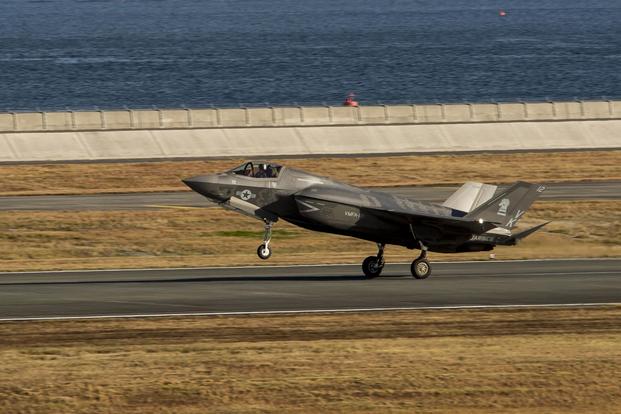The Marine Corps may struggle to support the ongoing deployment of its F-35B Joint Strike Fighter to the Pacific if the Defense Department won't properly share the service's operational challenges to the Navy or Air Force, according to a new Government Accountability Office report.
The GAO issued a report Wednesday saying that the Marine Corps relies too heavily on "personal relationships" with Air Force and Navy counterparts to share lessons learned from not only its first operational F-35 deployment, but also training exercises.
The Defense Department "has emphasized the need for the services to collect and share lessons learned not only at a service-specific level, but across all services, and it established the Joint Lessons Learned Program in 2000 to enhance joint capabilities through knowledge management in peacetime and wartime," the 15-page report said.
Related content:
- Navy Confirms Plans to Send Carrier-Capable F-35C to Iwakuni by 2021
- It's Official: Air Force F-35s Will Deploy to Asia in November
- Marine F-35Bs Arrive on USS Wasp for First Shipboard Deployment
"The goal is to prevent lessons learned from being captured in a vacuum within each military service, but rather to have them captured and shared among the joint force to create, among other things, better doctrine, policy, training and education," it said.
As deployments continue to expand for all three services in the Pacific, GAO officials said they're worried more deployments to the theater may have additional hiccups if information isn't communicated on a larger scale.
For example, the report said the Marines have noticed obstacles in the F-35B stealth fighter's first deployment to Marine Corps Air Station Iwakuni, Japan. The B-variant is capable of short take-off and vertical landings, allowing it to operate from amphibious ships.
"In particular, it is uncertain how long the F-35 can effectively operate if its Autonomic Logistics
Information System [ALIS] becomes disconnected from the aircraft," the report said.
ALIS is the main computer ground support system for the aircraft, which has had a few setbacks of its own in recent months as the Joint Program Office aims to correct issues with the software.
Furthermore, the Marine Corps has noticed supply-chain snafus including shortage of parts in the F-35 supply chain; longer repair time for certain parts; inaccurate estimated arrival time for these parts (with some only coming from the U.S.); and delays at customs, according to the report.
GAO's recommendation to make information more accessible across the services operating the F-35 has already been accepted by the Joint Program Office and the Pentagon, the report said.
In responses included in the report, DoD also said it will continue to evaluate ALIS's performance, and that it agrees "future testing is worthwhile."
DoD said it will start communicating through a new "electronic forum repository" for lessons learned, but did not specify where or how the forum will be based.
"As F-35 operational exercises grow, the department will continue to share lessons learned through the existing [operational advisory group] and [supportability advisory group], using a new electronic forum repository," Kristin French, principal deputy assistant secretary of defense and acting assistant secretary of defense for logistics and materiel readiness, wrote in her response.
The news surrounding the Marine Corps' F-35 Pacific deployment comes as the Navy is preparing to deploy its F-35 to Iwakuni, Japan, in roughly the next three years.
Carrier Air Wing 5 is expected to receive the F-35C sometime after 2021. The Navy's F-35Cs are designed to take off and land on aircraft carriers.
-- Oriana Pawlyk can be reached at oriana.pawlyk@military.com. Follow her on Twitter at @oriana0214.










